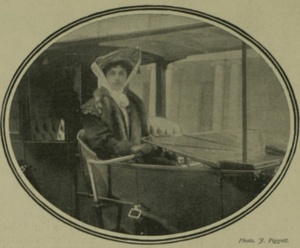Cleone Benest facts for kids
Quick facts for kids
Cleone Benest
|
|
|---|---|

Benest, ca. 1908, image by F. Piggott
|
|
| Born |
Cleone de Heveningham Benest
13 June 1880 Forest Gate, East London, England
|
| Died | 23 December 1963 (aged 83) |
| Nationality | British |
| Other names | C. Griff, C. de Benest, Cleone de Heveningham B. Griff |
| Occupation | engineer |
| Years active | 1907–1953 |
Cleone Benest (born June 13, 1880 – died December 23, 1963) was a truly groundbreaking British engineer. She was also a pioneer in driving cars and an expert in metals, known as a metallurgist. Cleone was one of the very first women to pass difficult mechanical exams. These exams were from important places like the City and Guilds of London Institute, the Royal Automobile Club, and Portsmouth Municipal College. She wrote many articles about engineering. She even started her own company, which was managed and run completely by women. From 1922 to 1926, she was the leader of the Women's Engineering Society.
Contents
Cleone Benest: A Pioneer Engineer
Early Life and Moving Around
Cleone de Heveningham Benest was born on June 13, 1880, in Forest Gate, London. Her parents were Edith Maria and George Philip Benest. When she was young, her parents separated. Cleone then moved to St. Aubin on the Isle of Jersey. She lived there with her mother and grandparents. In the early 1890s, her family moved again. This time, they went to Ryde on the Isle of Wight.
Driving and Engineering Achievements
By the early 1900s, Cleone Benest was already famous. She was known as a pioneering motorist. She owned two cars: a 1906 Lanchester Motor Company 12-horsepower car and a 12-horsepower Fiat. She took care of both cars in her own workshop.
Firsts in Motor Engineering
In 1907, Benest asked the Institution of Automobile Engineers if women could join. By 1908, she had passed several important tests. These included the City and Guilds of London Institute's motor-engineering exam. She also passed the Royal Automobile Club's mechanical test. This made her a certified driver. She was noted as the first woman to take the motor engineering exam. She was also the first to drive a motor omnibus (a type of bus). She drove Milnes-Daimler and Thornycroft buses for a company on the Isle of Wight.
Benest also loved to compete in motorsport competitions. Until 1911, she was also a fencer. She was part of the British Ladies Fencing Association. In 1910, she took an exam at Portsmouth Municipal College for heat engines. That same year, she entered a design for a speed alarm. This was for a competition held by Flight magazine. She was the only woman among 39 competitors. Her design was published in the magazine.
Designing and Consulting
By 1915, Benest started using the professional name C. Griff. Sometimes she was also known as Cleone or Clayton Griff. She ran a consulting business. It focused on automotive, electrical, and mechanical engineering. Her office was in Dover Street in Mayfair, London. This was very close to the headquarters of the Women's Engineering Society. She not only fixed machines but also taught courses in motor mechanics. In 1915, she wrote an article in Englishwoman's Year Book. In it, she explained that as machines were used more, there was a greater need to train women as engineers.
Leading the Way in Wartime
During World War I, Benest (using the name Griff) became an aircraft engine inspector. She moved to The Midlands. She first worked for the British Thomson-Houston Company. Later, she worked for Vickers Limited.
Aircraft Inspector and Society Chair
In 1920, she joined the Women's Engineering Society. In 1922, she was chosen to be its chair (leader). She held this position until 1926. She wrote articles for The Women Engineer journal. She also gave several talks about engineering on the radio. Around this time, she also started attending meetings of the Institute of Automobile Engineers. She was invited as a guest. This was because their rules did not officially allow women to be members.
Her Own Company: Run by Women
In 1922, she started a new company in Birmingham. It was called The Stainless Steel and Non-Corrosive Metals Company Limited. Her company directors were also women. These included Gabrielle Borthwick, Gertrude Crawford, and C. Davis. The company received a lot of attention in the news. People were impressed that it was managed and run by women. The company used Benest's special coloring method. They made lamp reflectors, ornaments, railway parts, and other items. The company closed in 1925.
Throughout the 1920s, Benest (as Griff) wrote articles and gave talks. These were about stainless steel and how it could be used in industry. She regularly wrote for the Woman Engineer magazine. She wrote about aviation and driving until 1927. She also gave talks on a BBC Radio program called Afternoon Topics. These talks were about engineering and how electricity could be used in homes. She stayed in Birmingham until 1928. Then, she suddenly left the Women's Engineering Society. She also stopped using the name Griff. She might have gone back to Ryde to take care of her mother, who passed away in 1930.
By the start of World War II, Benest was living in England again. She was with an engineer named Frederick J. Crinage in Olney, Buckinghamshire. She joined the Women's Land Army. She also advertised her services as a mechanical engineer and a metallurgist (metal expert). She also called herself a "Gyrotillage executive." Gyrotillers were huge, industrial farming machines. They were used to prepare land for growing food. We don't know if Benest operated these machines or maintained them. She stayed in Olney until 1953. After that, she lived in Dorset.
Later Years and Legacy
Cleone Benest passed away on December 23, 1963, in Poole. She is remembered as one of England's pioneering women engineers. She helped open doors for other women in engineering.

